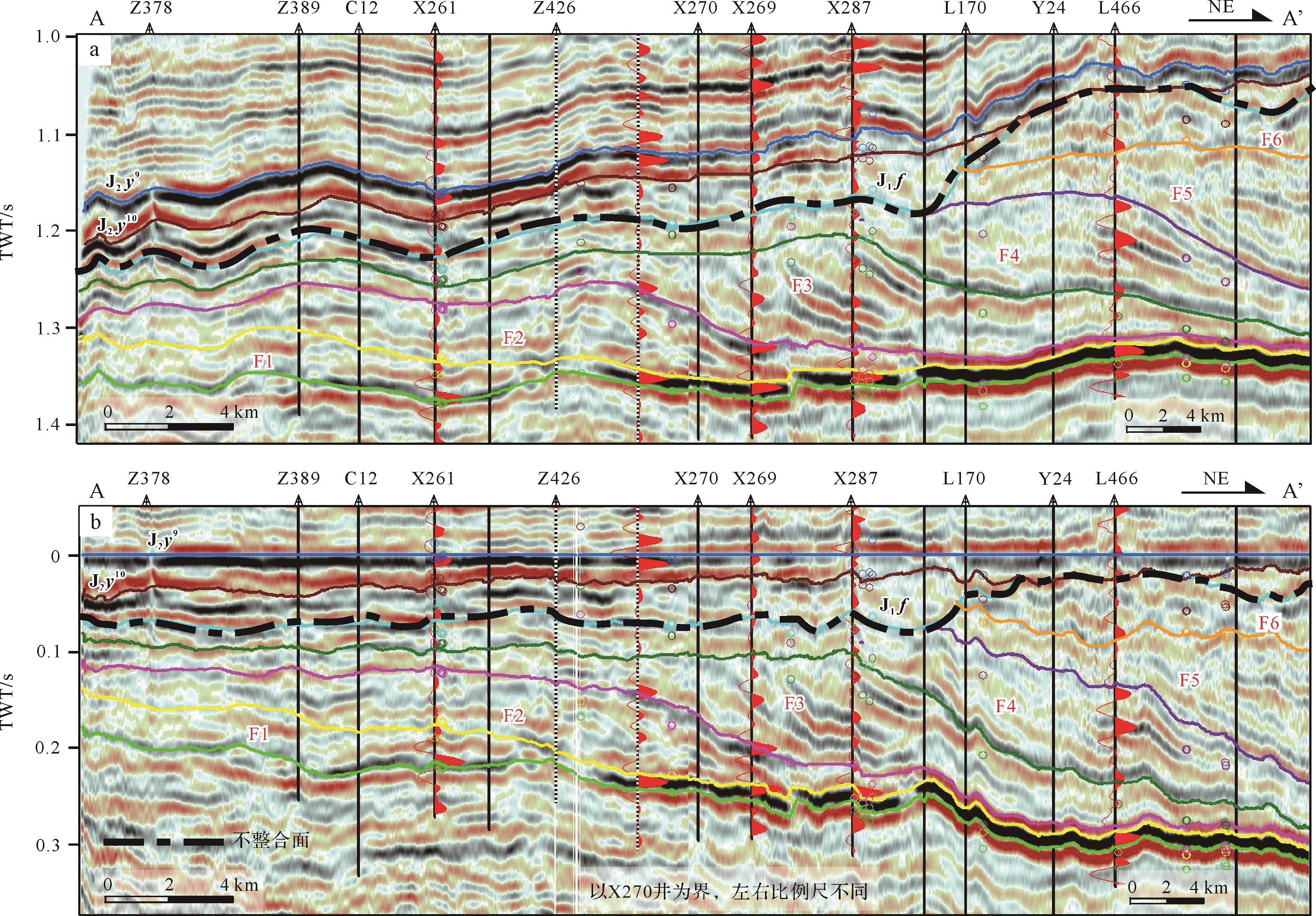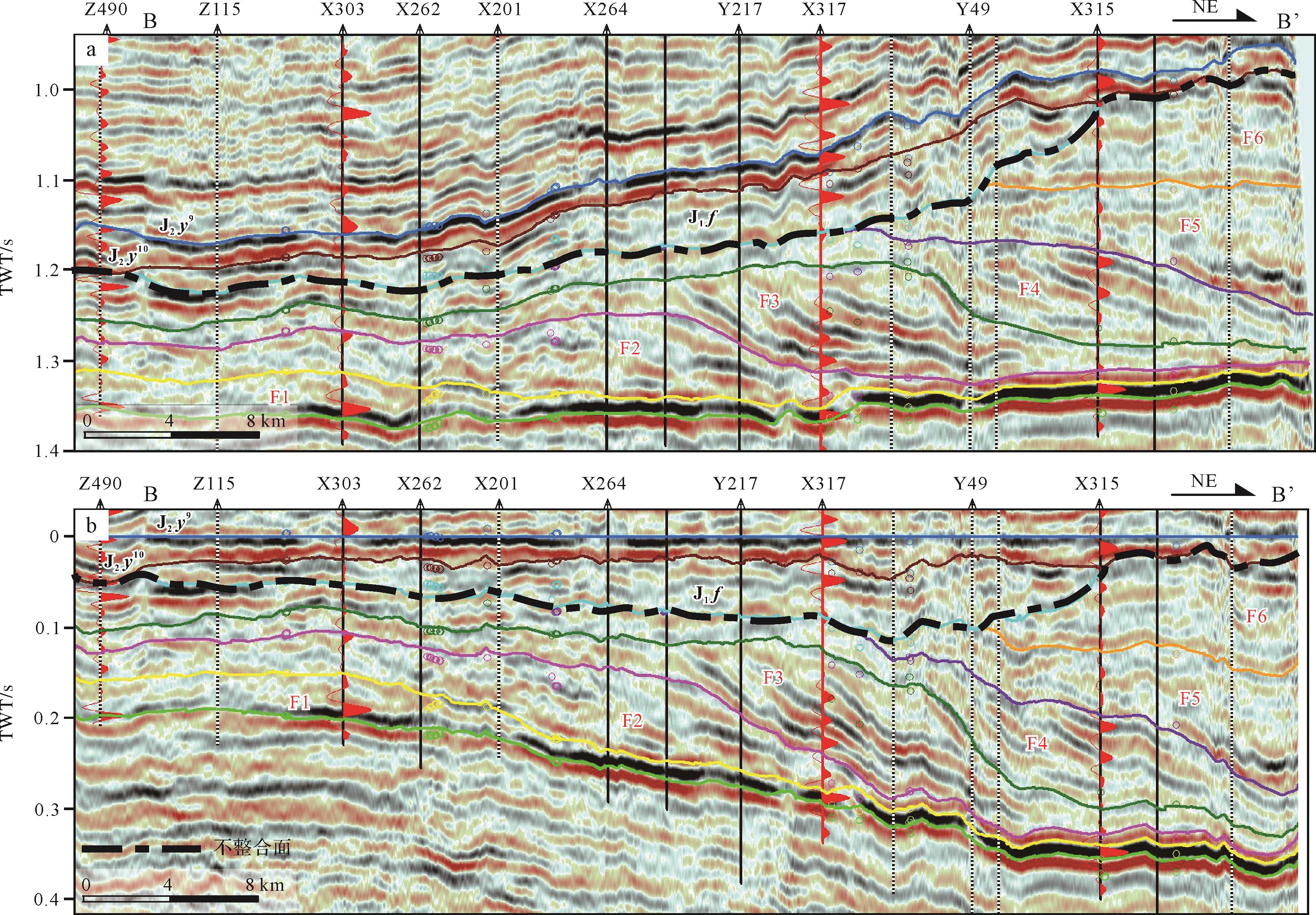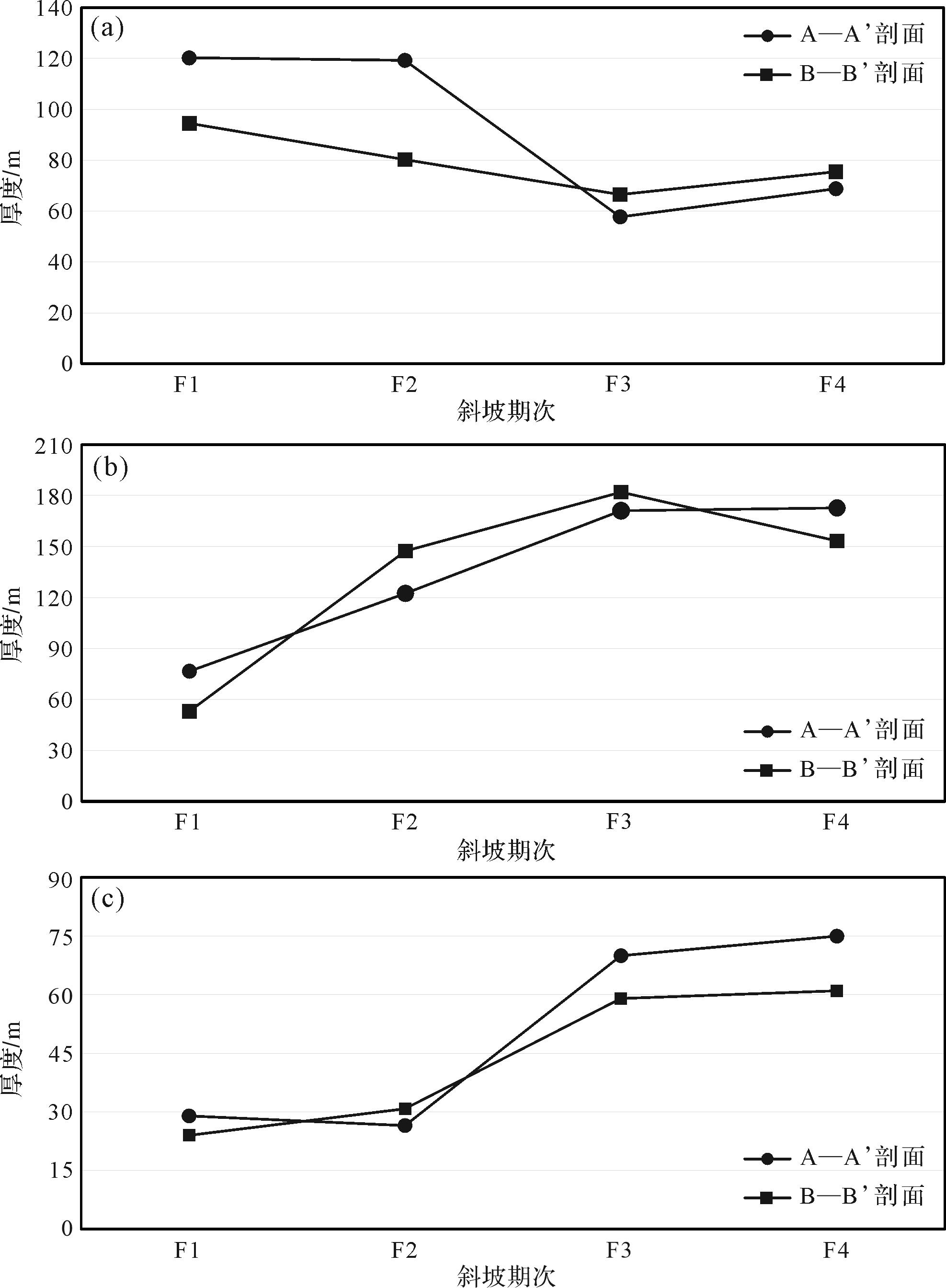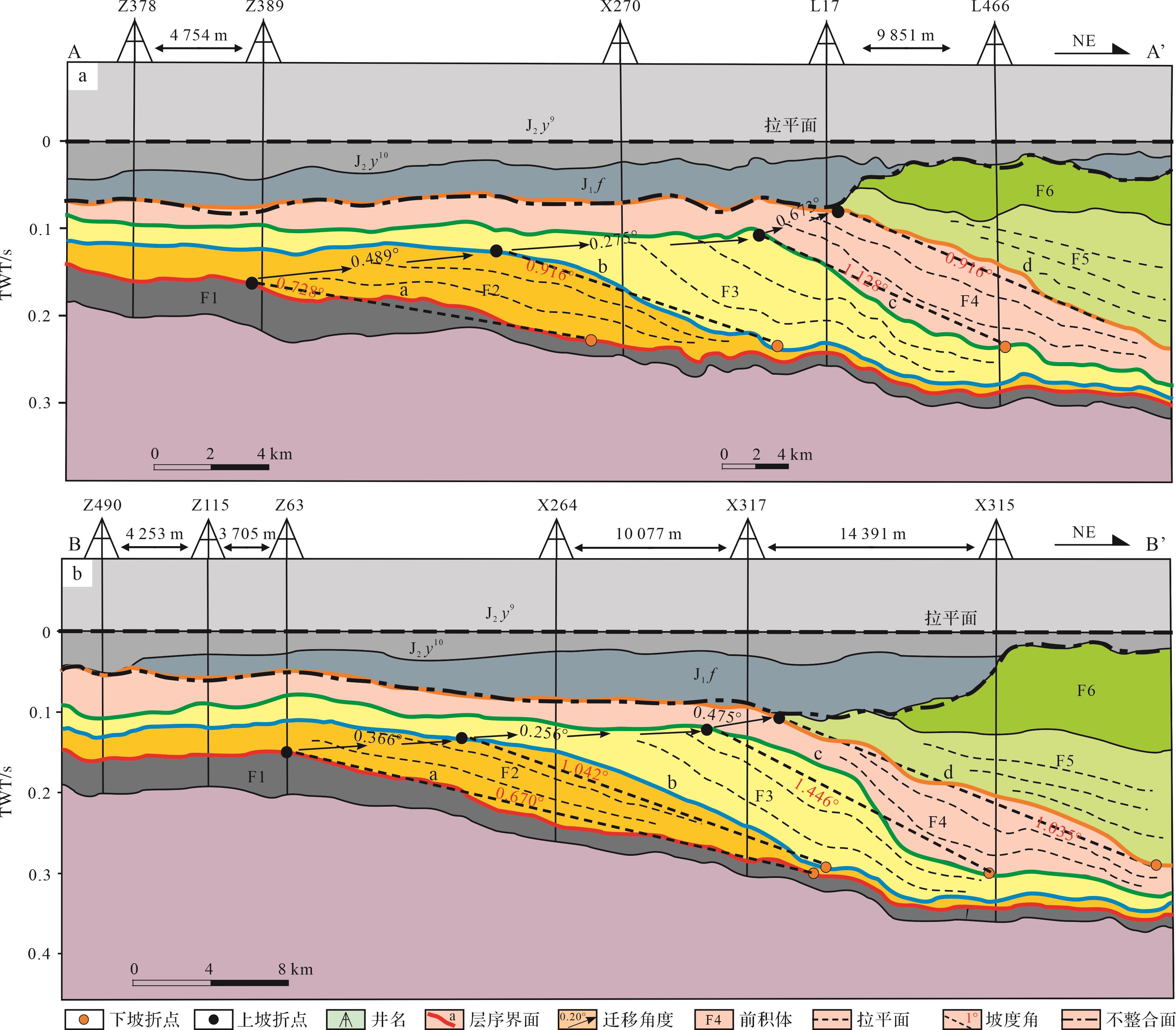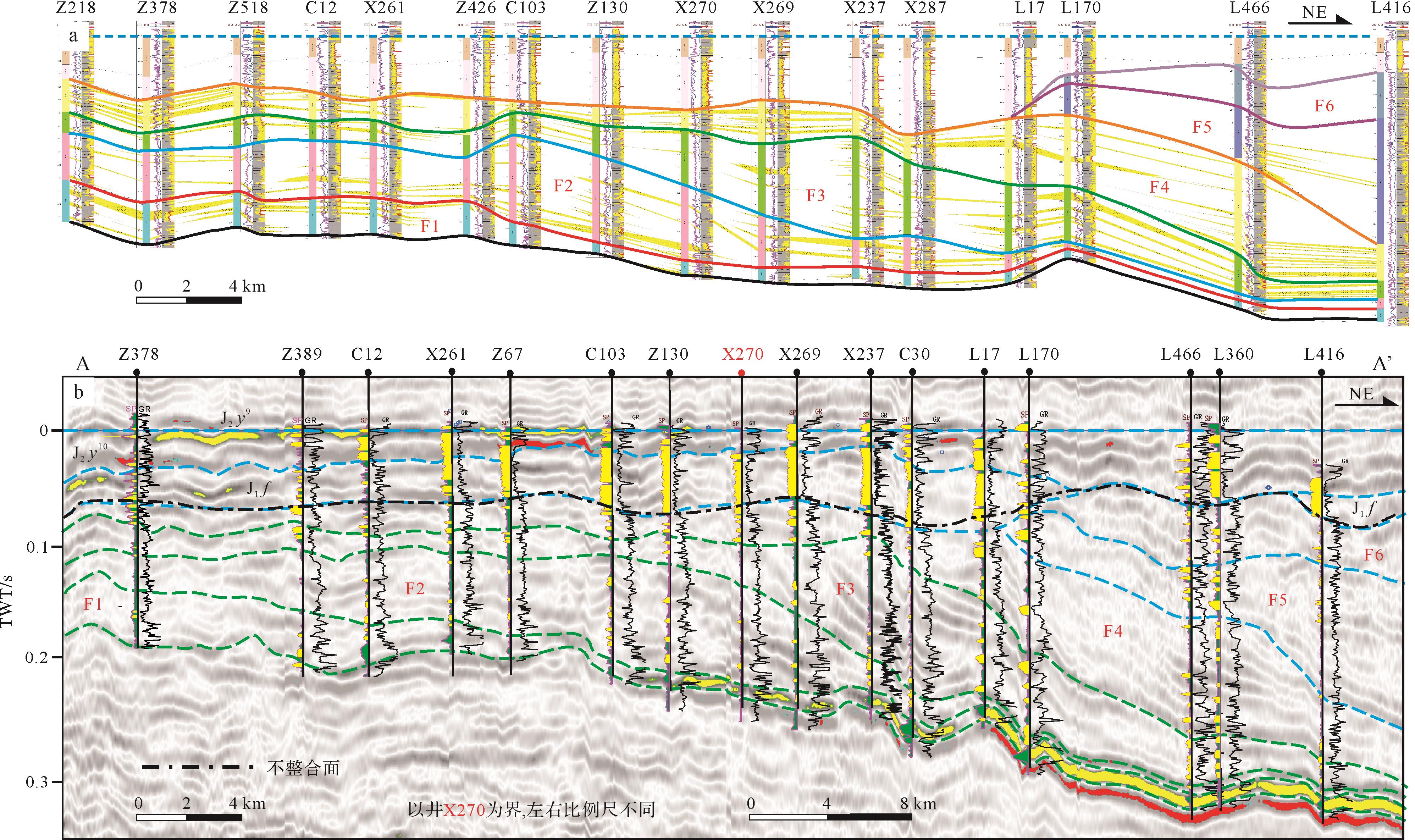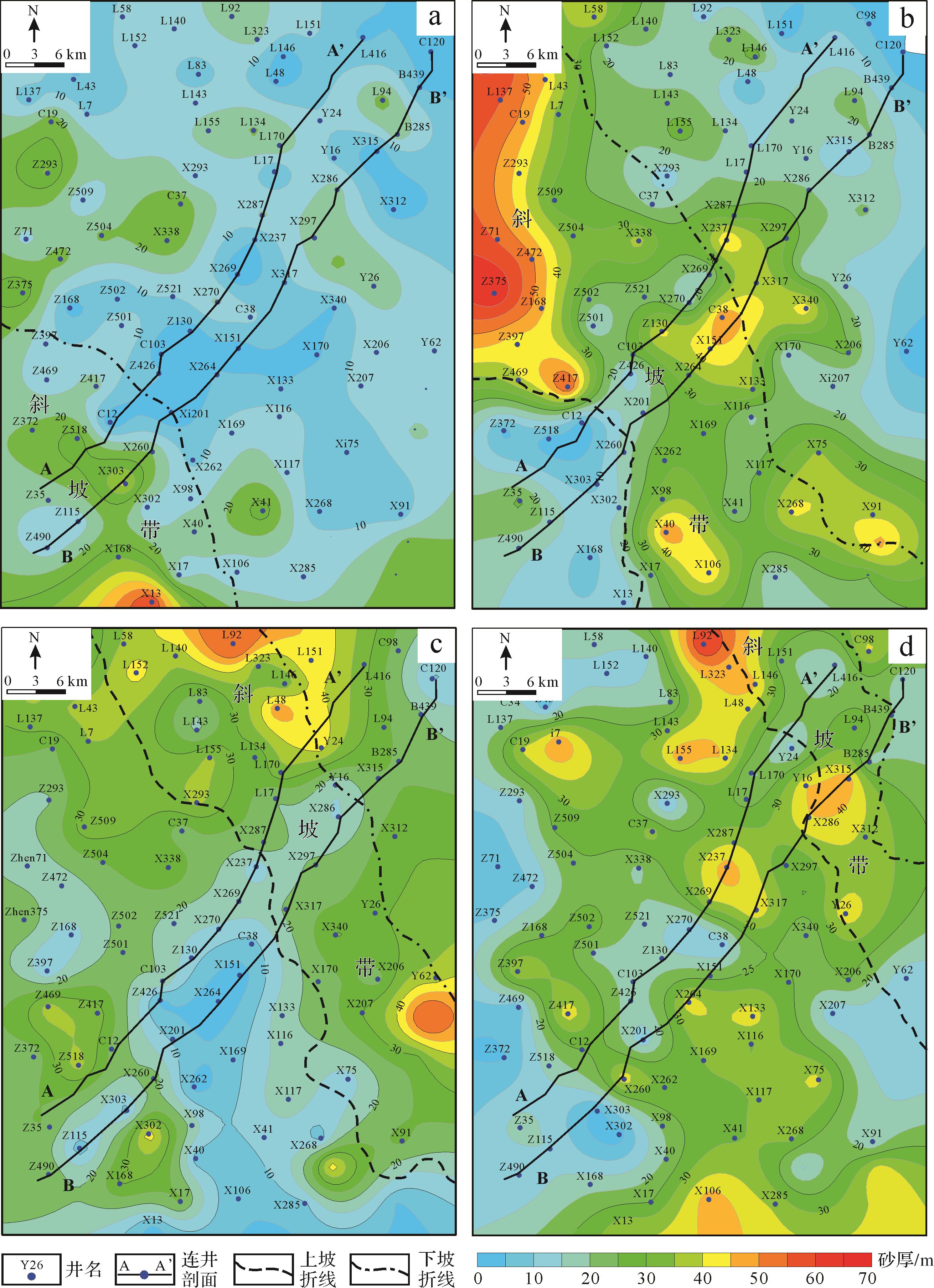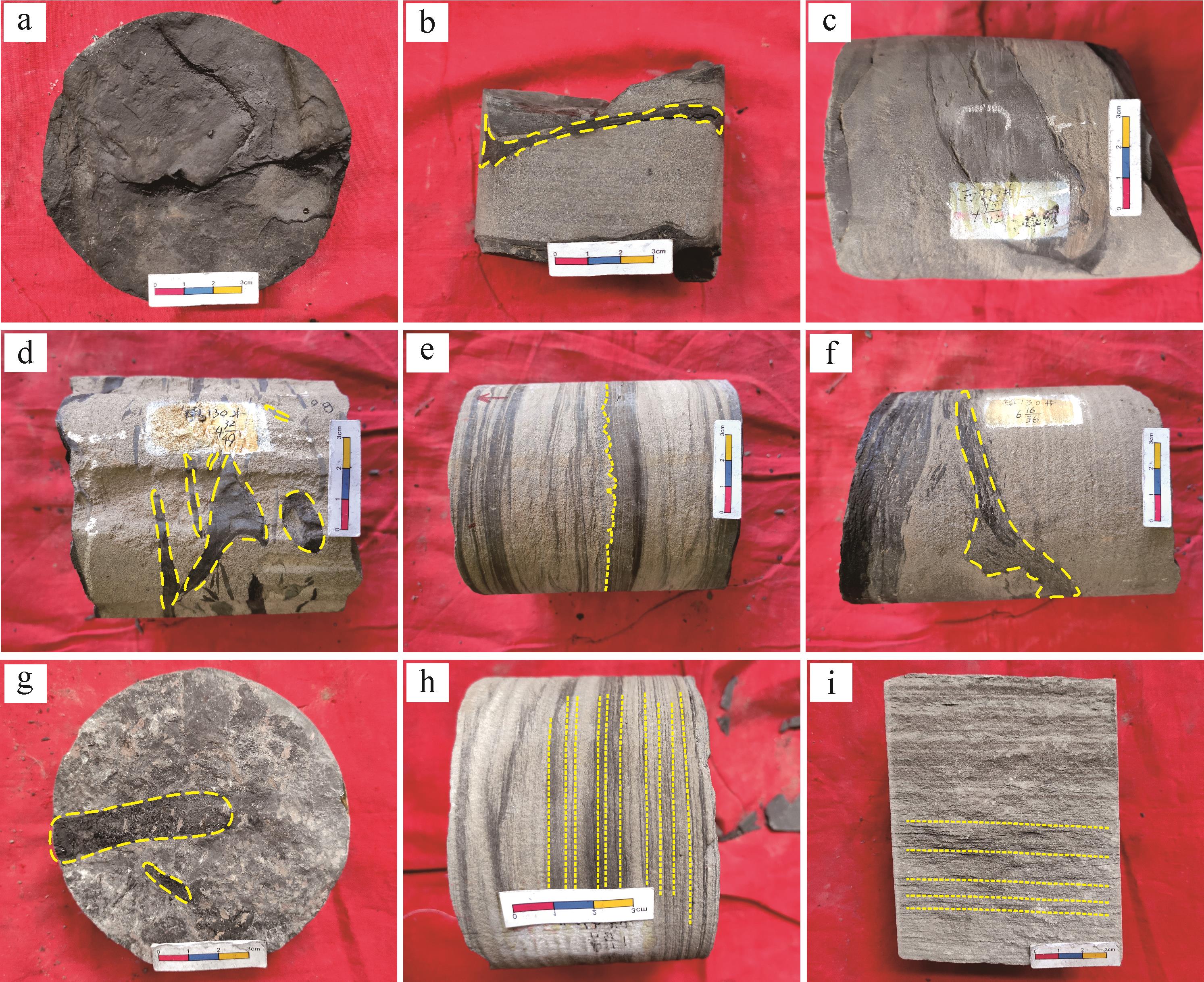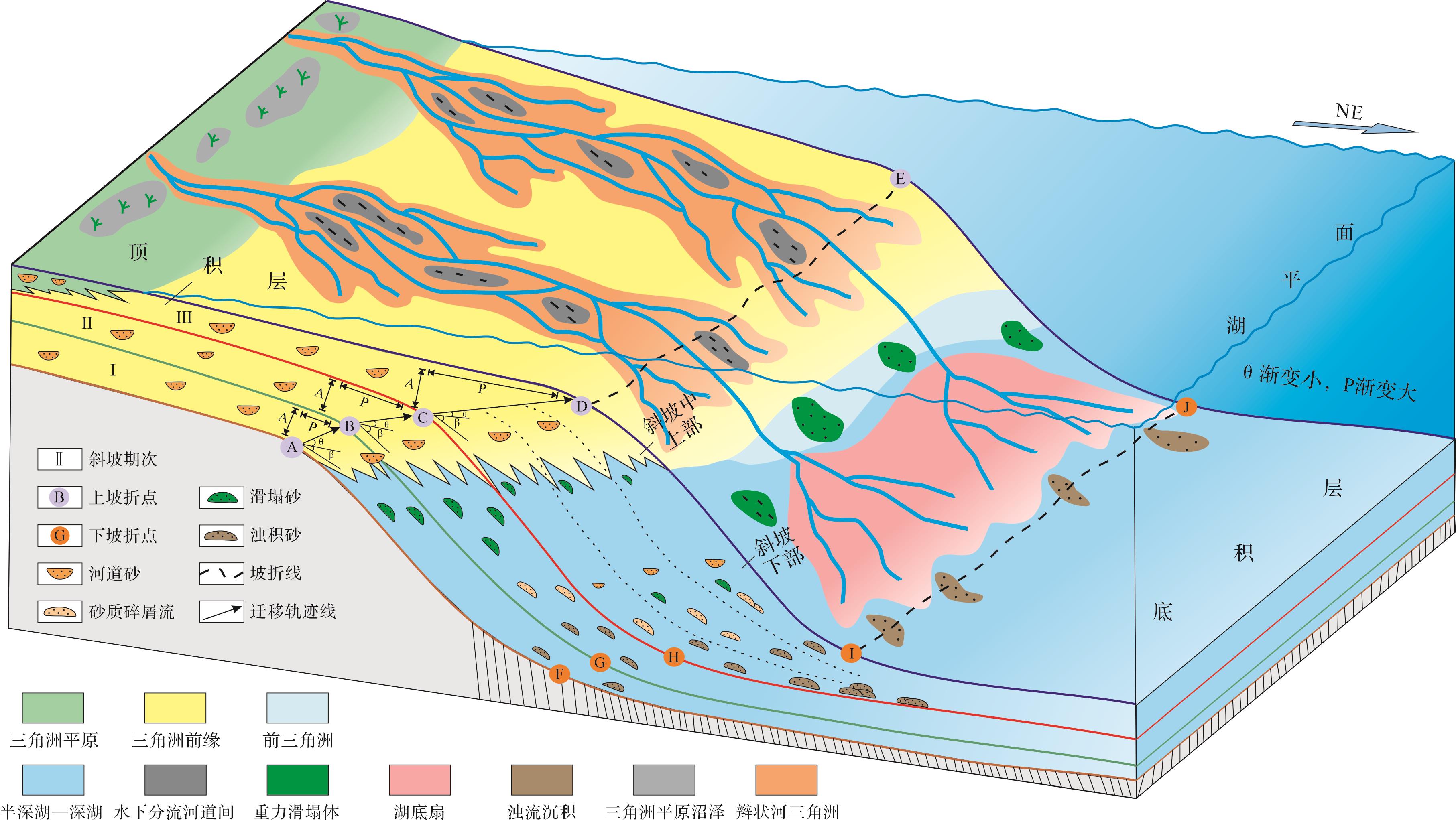HTML
-
前积斜坡可出现在湖泊或海洋的滨岸环境、大陆架内部和大陆边缘。具有等时意义的、向盆地倾斜的沉积界面称为斜坡地形(clinoform);由不同斜坡地形所夹的等时岩石单元称为(前积)斜坡沉积或斜坡岩层(clinothem)[1⁃2]。完整的前积斜坡包含相对平坦的顶积层、向盆地倾斜的前积层和低缓的底积层[2]。斜坡体的内部结构和外部形态,反映地层的堆叠方式,可用于恢复大陆或者湖盆边缘的古底形、古水深,揭示海/湖平面升降以及气候变化、沉积物分散样式等[3⁃6]。前人在陆架边缘斜坡沉积的研究过程中发现,前积斜坡深水区沉积物分散样式和坡折迁移轨迹有较好的耦合关系[2,7⁃14]。坡折迁移轨迹具体是指滨线或陆架边缘坡折点随时间推移而形成的路径[3],可用于分析湖/海平面的变化和沉积体系的演化[7,15]。根据形态特征可将坡折迁移轨迹分为上升型、平坦型和下降型三种类型[8]。迁移轨迹分析是对斜坡沉积的横向—垂向地貌特征和相应沉积物分散样式的剖析[3,7],重点关注坡折点迁移的路径和方向。以往关于坡折迁移轨迹与沉积物分散样式之间关系的报道,多数为大陆边缘海洋沉积环境[9⁃14],而对陆相湖盆方面的研究甚少,目前的报道仅有匈牙利Pannonian盆地[16]、罗马尼亚Dacian盆地[5]、渤海湾盆地[17⁃18]等有限的实例。其中关于坳陷型湖盆的斜坡生长及其与砂质沉积物分散样式的响应关系,尚未有相关报道。
鄂尔多斯盆地三叠纪延长组沉积期为一大型内陆坳陷湖盆,沉积了一套厚1 000~1 400 m的碎屑岩建造[19],是该盆地石油勘探的主要层系。近年来,随着三维地震勘探的加强,在延长组三角洲—深湖沉积过渡地带识别出不同类型的前积斜坡体,其中盆地东北部以低角度叠瓦状为主,而西南部则以高角度斜交型、“S”型为主,主要发育在延长组长7以上的层位[20]。研究区庆城地区位于鄂尔多斯盆地的西南部,区内延长组前积斜坡发育,现象典型,为研究坳陷湖盆斜坡地形下沉积物分散样式提供了较好的实例。近年来,已有关于延长组前积斜坡的研究报道[20⁃23],前人工作主要涉及斜坡类型、古水深恢复以及地层等时划分等方面,而关于斜坡生长与砂体分布的关系尚缺乏深入研究。本文运用斜坡生长相关理论和方法,对庆城地区延长组中上部发育的多期前积斜坡进行了精细解剖,并分析了斜坡生长与砂体分布的内在联系。
-
鄂尔多斯盆地是我国重要的能源盆地,富集石油、天然气、煤炭等资源[24⁃25]。晚三叠世延长组沉积期为大型内陆坳陷湖盆[26],经历了形成、扩张、萎缩、消亡四个演化阶段[27]。受控于构造沉降、物源供给及基准面的变化,在长7段沉积期湖盆发育达到鼎盛,之后经历了多期湖侵—湖退沉积旋回,至长1段沉积后湖盆萎缩消亡[28⁃29]。
勘探表明,盆地石油资源主要赋存于中南部地区的三叠系延长组[30],延长组沉积中心位于盆地中南部,呈北西—南东向展布,湖盆主要存在东北和西南两大沉积物源体系[31⁃32]。其中,东北部距物源区较远,古地形较缓,沉积体系主要为曲流河三角洲[33]。研究区庆城地区处于盆地的西南部(图1a),主要接受来自秦岭的近物源供给,古地形较陡,多发育辫状河三角洲体系[34⁃35]。
-
结合井—震资料,对主干地震剖面进行斜坡期次划分,识别出延长组中上部主要发育6期前积斜坡体,依次命名为F1~F6(在冲积平原区与传统等厚分层基本一致),受印支运动抬升作用影响,F5~F6仅保留湖盆中心部位的沉积。晚三叠世末的印支运动,使该盆地发生短暂的抬升剥蚀改造,形成了起伏不平的古地貌,之后又填平补齐式地接受了侏罗纪沉积,造成三叠系延长组在盆地不同部位分别与富县组或延安组呈区域不整合接触[24]。鉴于鄂尔多斯盆地整体升降的演化特点,选取侏罗系延安组延9段标志性煤层作为基准面进行拉平处理,可基本消除富县组古河道对层拉平产生的影响,近似反映延长组各期沉积结束的基准面(图2b、图3b)。主要对保存较为完整的F1~F4斜坡体进行分析。
研究区主要接受来自西南和南部的物源供应。从顺物源方向的地震剖面观察,F1~F4期斜坡体的外部形态相似,呈透镜状。4期斜坡体均具有完整的斜坡结构,发育厚度不一的顶积层、斜坡层和底积层。内部地震反射结构呈“S”型。
斜坡分类常依据外部形态和内部反射结构[20⁃21]。据上述特征,4期斜坡体可统一归类为透镜状“S”型。此外,也可依时间跨度进行斜坡分类。Johannessen et al.[9]认为,时间尺度上,斜坡可分为4个级别:4~6 My、1~2 My、100’s ky和10’s ky。依据项目内部资料,研究区Z389井及L14井的凝灰岩锆石定年数据,得到F1期地层最小年龄为235 My,F3期最小年龄为210 My。前人对长7油层组底部和上部的凝灰岩碎屑锆石定年数据显示,长7年龄介于221.8~228.2 My[36]。故单个斜坡沉积单元沉积时间大致为4~6 My尺度。
为定量表征斜坡体结构,利用顶积层厚度与斜坡层厚度的比值,进行斜坡分类和表征。用“H顶/H斜”比值,反映地层相对厚薄。以厚度比值“1.00”为基准,比值大于1.00为“顶厚+斜薄”型,比值小于1.00为“顶薄+斜厚”型。据此将研究区内4期斜坡体分为两类(表1):“顶厚+斜薄”型(F1期)、“顶薄+斜厚”型(F2~F4期)。
剖面名称 期次 H顶/m H斜/m H底/m H顶/H斜(均值比) 斜坡类型 A—A’ F1 115~133120.25(116.5) 42~10676.6(81) 24~3229(29.5) 1.569 顶厚+斜薄 F2 98~132119.25(123.5) 51~187122.33(128) 19~3526.5(26) 0.975 顶薄+斜厚 F3 43~7557.71(59) 119~248171.14(167) 43~9770(70) 0.337 顶薄+斜厚 F4 45~8268.83(71) 132~227172.71(161) 75 0.398 顶薄+斜厚 B—B’ F1 78~11494.5(93) 31~9553.1(47) 20~3024(23) 1.779 顶厚+斜薄 F2 59~9780.25(82.5) 92~195147.28(133) 20~4330.83(30) 0.544 顶薄+斜厚 F3 60~9166.5(65) 72~282182(162.5) 50~6559(62) 0.365 顶薄+斜厚 F4 66~10975.5(74) 61~200153.33(167.5) 61 0.492 顶薄+斜厚 注: 115~133,表示地层厚度分布范围为115~133 m;120.25(116.5),表示地层平均厚度为120.25 m(地层中值厚度为116.5 m)。Table 1. Clinothem thickness statistics in representative profiles in the Qingcheng area, southwestern Ordos Basin
-
斜坡体特征可依据其地层厚度、形态、坡度等进行描述。利用井—震结合剖面,统计相关几何参数(表1、图4)。

Figure 4. Variation of average clinothem thickness from the Yanchang Formation in the Qingcheng area, southwestern Ordos Basin
对研究区内顺物源的典型地震剖面分析表明,F1地层整体偏薄,其中顶积层稍厚,斜坡层和底积层较薄,为不对称“S”形态;顶积层呈中弱振幅—低连续反射,厚度介于90~120 m;斜坡层为中弱振幅—低连续反射,厚度介于40~80 m;底积层为中强振幅—高连续反射,厚度介于20~30 m。F2呈不对称“S”形态;顶积层为弱振幅—低连续反射,厚度介于80~110 m;斜坡层为中强振幅—中连续反射,厚度介于80~180 m;底积层为中强振幅—高连续反射,厚度介于20~40 m。
F3、F4具有中间厚—两端薄的对称“S”形态。其中,F3期:顶积层为弱振幅—低连续反射,厚度介于50~70 m;斜坡层具有中强振幅—中高连续反射,厚度介于100~200 m;底积层为弱振幅—弱连续反射,厚度介于40~70 m。F4期:顶积层为中弱振幅—低连续反射,厚度介于50~90 m;斜坡层具有中强振幅—中高连续反射,厚度介于90~180 m;底积层厚度介于60~70 m。
对比地层厚度及斜坡坡度(β)(表2),认为斜坡层厚度与形态具有相应变化规律。F1~F4期斜坡层厚度整体呈变厚趋势,在形态上,由不对称的“S”形态转变为对称“S”形态,在坡度上,呈整体变陡趋势。物源供给对斜坡的形成至关重要,而高速的物源供给易形成过路沉积,产生较陡的沉积坡度[4]。例如,F3期坡度较陡且沉积厚度较大,表明该时期物源较为充足。总体而言,从F1至F4期,沉积总厚度及坡度的变化趋势,表明物源供给量整体增加,供应速率逐渐变大,湖盆可容纳空间逐步减小。
剖面名称 期次 迁移区间 A/m P/km A/(P×103) 迁移角度θ/(°) 迁移类型 斜坡体顶界面 斜坡高度Rc/m 顶界面斜坡段坡度β/° A—A’ F1 — — — — — — a 149 0.728 F2 a-b 70 8.185 0.008 5 0.489 平坦 b 181 0.916 F3 b-c 64 13.074 0.004 8 0.275 平坦 c 285 1.128 F4 c-d 47 3.998 0.011 7 0.673 低角上升 d 254 0.916 B—B’ F1 — — — — — — a 328 0.670 F2 a-b 48 7.489 0.006 4 0.366 平坦 b 341 1.042 F3 b-c 60 13.421 0.004 4 0.256 平坦 c 399 1.446 F4 c-d 30 3.600 0.008 3 0.475 低角上升 d 388 1.035 注: F1期斜坡未作迁移角度计算。Table 2. Typical clinothem parameters used to describe shoreline trajectory in the Qingcheng area, southwestern Ordos Basin
-
为定量表征斜坡体特征及其生长方式,引入相关参数:(1)结构参数:斜坡高度(Rc,单位m)、斜坡坡度(β,单位°)、加积高度(A,单位m)、进积距离(P,单位km)、迁移角度(θ,单位°)、A/P值等;(2)物源供给参数:加积速率(Ra,单位m/My)、进积速率(Rp,单位km/My)和横断面的净沉积物通量(cross-sectional net sediment flux,Fc,单位km2/My)。
斜坡结构参数几何意义如图5。物源供给参数计算公式如下[37⁃38]:
Ra=A /T (1) Rp=P /T (2) Fc=Rp×A× 10-3(3) 式中:T为时间尺度,单位为My。计算结果见下文表3。
剖面名称 期次 A/m P/km Ra/(m/My) Rp/(km/My) Fc/(km2/My) A—A’ F1 — — — — — F2 70 8.185 17.50 2.046 0.143 F3 64 13.074 16.00 3.268 0.209 F4 47 3.998 11.75 0.999 0.047 B—B’ F1 — — — — — F2 48 7.489 12.00 1.872 0.090 F3 60 13.421 15.0. 3.355 0.201 F4 30 3.600 7.50 0.900 0.027 注: 单个斜坡沉积时间跨度约为4 My。Table 3. Statistics of sediment supply of individual clinothems in the Qingcheng area, southwestern Ordos Basin
采用坡折迁移轨迹分析,研究斜坡生长与砂体分布之间的关系。其主要步骤为:(1)选取顺物源方向典型剖面,建立等时地层格架;(2)选取统一界面作拉平处理,识别坡折点的位置;(3)追踪坡折点的垂向、横向(向陆/湖盆方向)迁移轨迹,确定坡折迁移轨迹的类型(上升型、平坦型或下降型);(4)结合钻井取心、测井解释与地震资料,分析不同期次斜坡体对应的砂体发育特征。
-
坡折迁移角度的变化能够反映物源供给变化、湖/海平面升降等信息[3,9,39]。在陆架斜坡的边缘迁移角度分类中,细分为高角度上升型迁移(大于2°)、低角度上升型迁移、平坦型和低角度下降型迁移[12]。
坡折迁移方向指示湖盆的沉积充填过程。进积式的迁移轨迹,表明湖盆演化是以向沉积中心的纵向推进为主导。通过坡折迁移轨迹参数计算(表2),可分为两类坡折迁移轨迹:低角度上升型(0.5°~1.0°)与平坦型(0°~0.5°)。其中F1顶界面a的坡折点为地形坡折点,处于深水沉积环境。F2迁移角度介于0.366°~0.489°,F3迁移角度介于0.256°~0.275°,均属于平坦型。根据岩心观察,F2、F3期坡折点附近沉积环境以三角洲前缘为主,F2、F3期坡折点为地形坡折点。F4迁移角度介于0.475°~0.673°,为低角度上升型。根据岩心观察,F4期坡折点西南方向发育炭屑、煤线等代表浅水沉积的三角洲平原亚相沉积,坡折点向北东方向主要发育三角洲前缘沉积。因此,F4期坡折点为滨岸坡折点。综合地层厚度(H顶/H斜)、迁移角度、A/P比值,认为F1具有“加积型”地层叠加样式,F2、F3则为“强进积型”,F4为“加积与进积混合型”。
此外,比较斜坡坡度与迁移角度(图6),发现a、b、c、d四个界面的坡度呈现初始较缓,而后变陡,最后再变缓的变化特征。对应迁移角度表现出初始稍大,而后变小,最后再变大的趋势。平缓的迁移轨迹对应较陡的斜坡。F1沉积期,物源供应初始规模小,a界面的坡度受原始地形控制,物源因素影响小。F1沉积期之后,沉积物供应逐渐充足,物源对坡度的影响逐渐占主导,b、c、d界面整体变陡。由此推测,在较高物源供给速率影响下[5],具有平缓迁移轨迹的强进积型斜坡体,其斜坡坡度往往偏大。或因在平缓迁移轨迹下,多发生过路沉积,沉积物向湖心进积并堆积于斜坡区域,形成更陡的斜坡。较陡的坡度促进了重力流的形成,使得较多的砂质沉积物被搬运至深湖区。
3.1. 斜坡体期次及类型
3.2. 斜坡体厚度特征
3.3. 坡折迁移特征
3.3.1. 参数与方法
3.3.2. 坡折迁移轨迹类型
-
为分析不同斜坡生长方式下砂体的剖面分布特征,结合地震、测井资料,建立砂体分布连井对比剖面(图7,8)。通过对典型剖面进行观察,总结F1~F4期斜坡体的砂体优势部位及其演变规律。

Figure 7. Interpreted sand bodies in the inter⁃well section of A⁃A’ (a) and corresponding well⁃seismic tied profile (b) in the Qingcheng area, southwestern Ordos Basin

Figure 8. Interpreted sand bodies in the inter⁃well section of B⁃B’ (a) and corresponding well⁃seismic tied profile (b) in the Qingcheng area, southwestern Ordos Basin
由F1过渡至F4期,其砂体发育的优势部位不同,尤其在深水区分异明显,即斜坡层下半部和底积层砂体的不断变多。对比发现,F1期砂体多发育在顶积层和斜坡层上半部,底积层富泥;F2期,砂体富集于斜坡层,底积层、顶积层砂体较少;F3期,砂体多发育在斜坡层下半部、底积层,而较薄的顶积层中砂体较少;F4期,既含较丰富的顶积层砂体(浅湖区),亦有较丰富的斜坡层下半部及底积层砂体(深湖区)(图7,8)。
-
为揭示各期斜坡沉积的砂体平面分布及其变化规律,依据地震和测井解释,编制了F1~F4沉积期的砂体厚度图(图9)。结果表明,随着斜坡体向湖盆中心的推进,砂体厚度分布样式发生规律性变化。

Figure 9. Sandstone clinothem isopach in the middle⁃upper part of Yanchang Formation in the Qingcheng area, southwestern Ordos Basin
F1沉积期,湖盆规模最大,此时物源供给相对不足,斜坡层砂体相对较厚,累计厚度介于20~30 m。岩心观察表明,该期斜坡的底积层砂体主要为重力流成因。受地震、重力等影响,斜坡层上部发生滑塌,并向深湖区继续搬运。深湖区重力流砂体厚度偏薄(图10b),厚0~15 m,呈条带状展布。

Figure 10. Typical core pictures of the clinothem topsets, foresets, and bottomsets in the Qingcheng area, southwestern Ordos Basin
F2~F3沉积期,湖盆转变为过补偿沉积。坡折带之上的顶积层砂体渐多,砂体厚40~50 m,多为三角洲前缘砂。在物源充足的背景下,砂体经坡折带搬运至半深湖—深湖区,坡折带以下的砂体增多,厚度加大,其中斜坡层砂体厚度可达40 m。由于沉积物不断累积以及较陡的坡度,重力流沉积广泛发育(图10d)。过渡到湖盆中心处,底积层砂体薄,厚度介于0~10 m。
湖盆发展到F4沉积期,三角洲持续向湖盆中心进积,三角洲前缘沉积(图10h)范围更广,砂体也进一步向研究区东北方向推进。总体而言,F1砂体多分布于研究区西南部,F2、F3、F4砂体逐渐向研究区中部和东北部深湖区聚集。
-
斜坡生长方式具体表现为斜坡体的形态、迁移轨迹等方面。基于前文斜坡形态及迁移轨迹的分析,总结斜坡生长方式与砂体分布的关系。F1为加积型斜坡,具“顶厚+斜薄”特征,砂体多发育于斜坡体中上部。F2~F3为进积型斜坡,呈“顶薄+斜厚”特征,具有平坦型轨迹,斜坡层下半部富砂。F4为加积—进积混合型斜坡,具有低角度上升型轨迹,顶积层及斜坡层下半部富砂。由此认为,随着加积型斜坡转变为进积型斜坡(F1~F3)以及迁移角度的降低(F2~F3),砂体逐渐富集于深湖区(斜坡层下半部及底积层)。迁移角度的增加(F4)会提高加积高度,顶积层的砂体厚度因此增大。
此外,需要考虑迁移角度的增加对深湖区砂体的影响。研究区F4迁移角度比F2、F3有所增大,其深湖区砂体仍较丰富。造成这一现象的原因或为:(1)湖盆规模小且距源区更近,物源供给较充足;(2)湖平面上升快而周期短,形成的迁移角度较低(仍小于1°);(3)F4沉积期已进入湖盆演化末期,湖平面上升所增加的可容纳空间有限。因此,分析迁移角度变化与砂体分布的联系,需要综合物源、湖平面、湖盆演化阶段等因素。
4.1. 砂体剖面分布特征
4.2. 砂体平面分布特征
4.3. 斜坡生长与砂体分布的关系
-
控制斜坡生长方式及深湖区砂体分布的因素主要有物源、湖平面变化、气候等[4⁃5,9,12⁃14,18]。由于延长组整体的气候为温暖湿润环境,故气候因素并非造成延长组中上部前积斜坡差异性生长的主要因素。
-
在各个斜坡沉积期,其物源供给量不同。F1~F4期,物源供给表现为少量低速—大量高速—相对降速的变化过程(表3)。
F1沉积厚度较其他3期薄(表4),反映F1处于欠补偿沉积期,A/S值大于1,为高可容纳空间阶段。此阶段,形成加积型斜坡,砂体主要发育在顶积层,而深湖区富泥质沉积。F1沉积期之后,物源供应通量增加,湖盆由欠补偿沉积过渡为过补偿沉积,A/S值开始减小。在强物源供应背景下,进积速率增加,产生低角度上升型轨迹,形成进积型斜坡。其中,F3沉积期的进积速率与净沉积物通量处于高峰,形成平坦型轨迹,深湖区砂体富集程度远超F1期。因此,物源供给对研究区的斜坡生长及砂体分布具有主导作用。高物源供给通量与高供给速率,是深湖区砂体富集的重要因素。
剖面名称 期次 H顶/m H斜/m H底/m 总厚度/m 总沉积速率/(m/My) A—A’ F1 120.25 76.60 29.00 225.85 56.46 F2 119.25 122.33 26.50 268.08 67.02 F3 57.71 171.14 70.00 298.85 74.71 F4 68.83 172.71 75.00 316.54 79.13 B—B’ F1 94.50 53.10 24.00 171.60 42.90 F2 80.25 147.28 30.83 258.36 64.59 F3 66.50 182.00 59.00 307.50 76.87 F4 75.50 153.33 61.00 289.83 72.45 注: 单个斜坡沉积时间跨度约为4 My。Table 4. Average thickness and sedimentation rate of individual clinothems in the Qingcheng area, southwestern Ordos Basin
-
湖平面的升降影响湖盆可容纳空间的变化,控制湖盆斜坡的生长方式,调节沉积物的分散样式。水位变化幅度与进积速率(或物源供给速率)共同控制斜坡的形态[40⁃43]。
综合前人研究[22,27⁃28]及迁移轨迹分析,认为在湖退背景下,湖平面有多期短暂上升,但湖盆可容纳空间整体减小。在水体规模最大而物源供应弱时(F1沉积期),斜坡沉积速率较低,以加积式沉积为主。当湖平面下降而物源供给增强时(F2~F3沉积期),加积速率降低,进积速率增加,深湖区砂体变多。在物源供应整体稳定时(F4沉积期),湖平面上升,则加积速率增大而进积速率减小。因此,随着湖平面整体下降,研究区湖盆斜坡由加积型转变为进积型,迁移角度整体偏低,深湖区逐渐成为砂体重要富集场所。
基于前文斜坡形态、迁移轨迹以及物源供应等分析,认为研究区延长组斜坡生长方式及其砂体分布主要受控于物源供给与湖平面变化两大因素。随着物源逐渐充足以及整体性湖退,深湖区砂体由贫乏转为丰富(图11)。在低物源供给与高湖平面(高可容纳空间)影响下,斜坡进积速率低,深湖区砂体少。然而,在高物源供给及湖退(可容纳空间减小)的背景下,进积速率高,深湖区富砂。因此,高物源供给及湖平面下降是深湖区富砂的重要因素。
综上所述,在湖盆演化的F1~F4沉积期,斜坡体以进积方式向沉积中心推进,砂体被携带至湖盆深水区域,呈现出砂体向东北深湖区不断推进、分布范围扩大的趋势。F4沉积期之后进入湖盆演化晚期,则主要为垂向加积式的充填过程。
5.1. 物源供给
5.2. 湖平面变化
-
(1) 庆城地区延长组中上部存在斜坡生长现象,划分出F1~F4共4期发育较完整的斜坡体,4期斜坡体呈透镜状“S”形态。依据“H顶/H斜”比值,分为“顶厚+斜薄”型(F1期,H比值大于1)和“顶薄+斜厚”型(F2~F4期,H比值小于1)两类。
(2) F2、F3期的迁移轨迹为平坦型,F4期为低角度上升型。上升型迁移轨迹表明湖盆在整体湖退背景下,发生短期湖平面上升事件。3期迁移轨迹向湖盆中心推进,表明湖盆以进积方式充填。基于迁移轨迹与地层厚度,认为F1为“加积型”斜坡,F2、F3为“强进积型”斜坡,F4为“加积与进积混合型”斜坡。
(3) 物源供给与湖平面变化是研究区斜坡生长及砂体分布的主控因素。低沉积物供给与高湖平面背景下,多形成加积型斜坡,具有上升型迁移轨迹,砂体多发育于顶积层和斜坡层上半部;高沉积物供给与湖退背景下,形成进积型斜坡,具有平坦型或低角度上升型迁移轨迹,砂体多发育于斜坡层下半部、底积层。研究区F1~F4期的砂体,平面分布上表现为由西南向东北推进且分布变广的趋势,剖面上呈现向深湖区的斜坡层和底积层聚集的趋势。

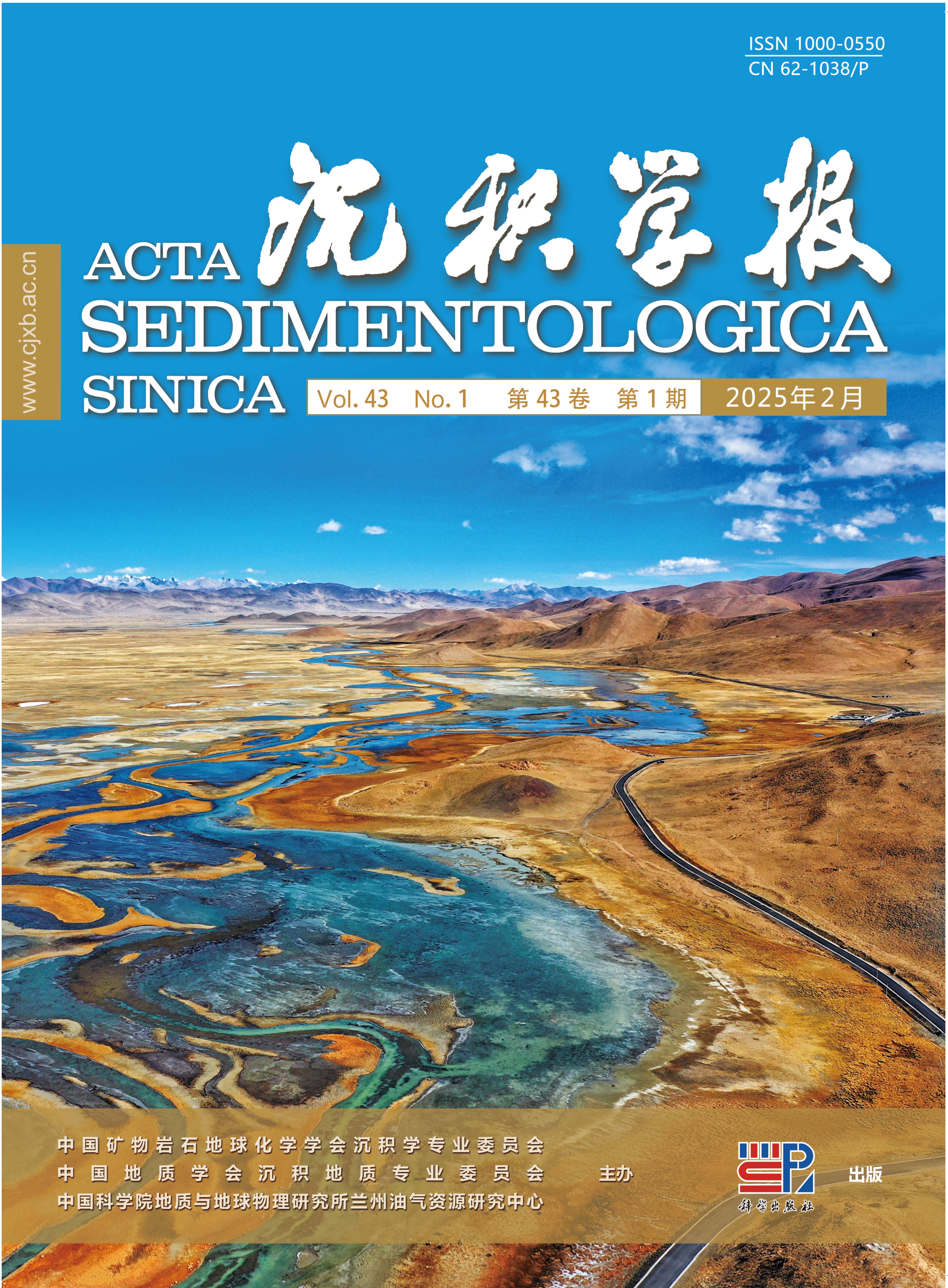


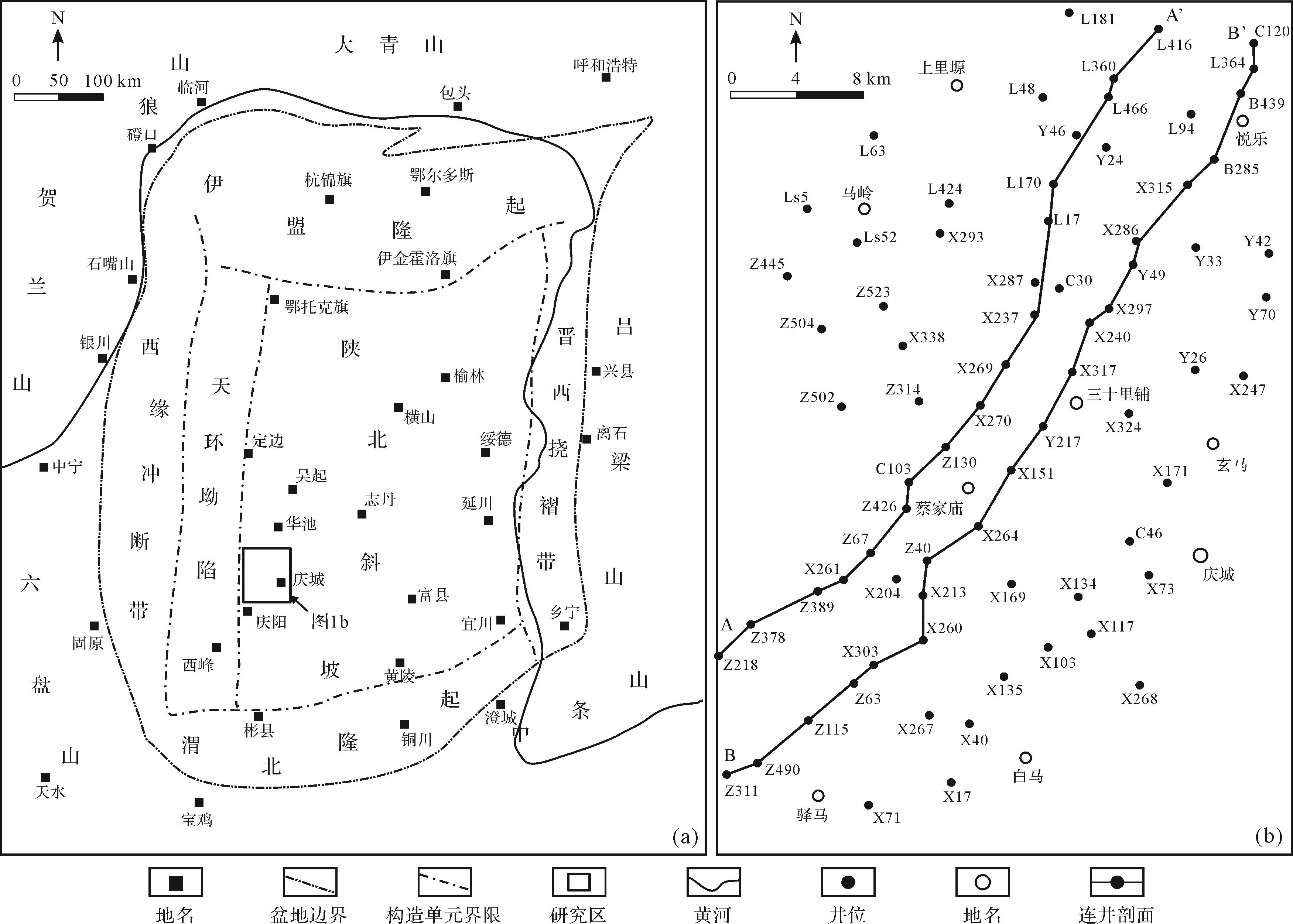







 DownLoad:
DownLoad:
